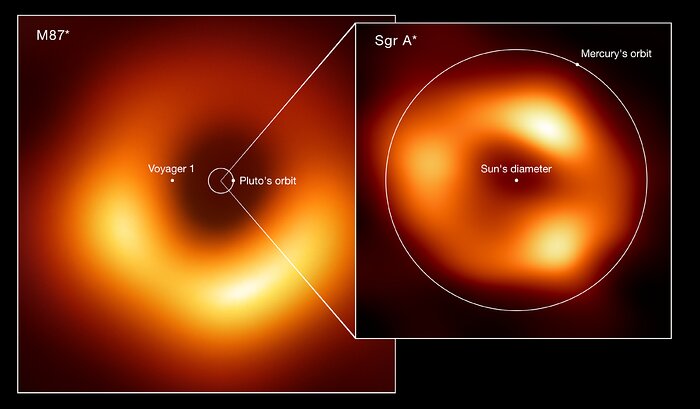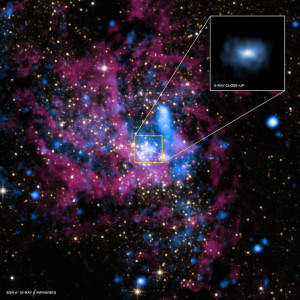Peter Lobner
Background
The first-ever direct image of a black hole was released on 10 April 2019 by the Event Horizon Telescope (EHT) team and the National Science Foundation (NSF). The target for their observation was the supermassive M87* black hole at the center of the distant Messier 87 (M87) galaxy, some 54 million light years away. The EHT team estimated that M87* has a mass of about 6.5 billion Solar-masses (6.5 billion times greater than the mass of our Sun), and the black hole consumes the equivalent of about 900 Earth-masses per day. One Solar mass is roughly equivalent to the weight of the Sun and about 333,000 times the mass of Earth. Gases orbiting around the giant M87* black hole take days to weeks to complete an orbit. For more information on the first M87* black hole image, see my 10 April 2019 article here: https://lynceans.org/all-posts/the-event-horizon-telescope-team-has-produced-the-first-image-showing-the-shadow-of-a-black-hole/
For decades, there has been mounting evidence that there is a massive black hole, known as Sagittarius A*, or Sgr A* for short, at the center of our Milky Way galaxy. Its presence has been inferred from the motions of visible stars that are orbiting under the gravitational influence of the black hole or are in the general vicinity of the black hole. Using observed data from more than 30 stars in the region around the galactic center, scientists developed high-resolution simulations that helped refine estimates of the location, mass and size of the Sgr A* black hole without having data from direct observations. For more information on this work, see my 24 January 2017 article here: https://lynceans.org/all-posts/the-black-hole-at-our-galactic-center-is-revealed-through-animations/
First-ever image of Sgr A*
On 12 May 2022, the EHT team and the European Southern Observatory (ESO) held a press conference and released the first-ever image to directly show the ring of glowing gas surrounding the Sgr A* black hole. You can read their press release here: https://eventhorizontelescope.org/blog/astronomers-reveal-first-image-black-hole-heart-our-galaxy
Initial EHT team and ESO results from their Sgr A* observations have been published and are available on The Astrophysical Journal Letters website here: https://iopscience.iop.org/journal/2041-8205/page/Focus_on_First_Sgr_A_Results

surrounding Sgr A*. Source: EHT Collaboration

X-ray/infrared NASA image of the heart of our Milky Way galaxy.
Source: EHT Collaboration & NASA
Even though it was much closer than M87*, getting an image of Sgr A* was much harder because the Sgr A* black hole had to be viewed through the densely populated central plane of our Milky Way. The Sgr A* radio frequency (millimeter wave) observations were made in 2017 at a wavelength of 1.3 mm (230 GHz), the same as the first image of M87*.
Details that have emerged so far from the Sgr A* observation include the following.
- Sgr A* is about 27,000 light years away, at the heart of our own galaxy (about 2 thousand times closer than M87*, which is in a different galaxy).
- Sgr A* has a mass is about 4 million times the mass of our Sun, which is just a small fraction (1/1,500th , or 0.07%) of the mass of M87*.
- The glowing gas ring surrounding the Sgr A* black hole has an outer diameter of about 72 million miles (115 million km) across, which is approximately the diameter of Mercury’s orbit around the Sun in our solar system. The EHT team reported, “We were stunned by how well the size of the ring agreed with predictions from Einstein’s Theory of General Relativity.” By comparison, M87* is vastly larger, with the inner black hole region measuring about 23.6 billion miles (38 billion km) across (about 330 times the diameter of the entire Sgr A* black hole, including the glowing gas ring), as shown in the following scale diagram.

Source: EHT Collaboration (acknowledgment: Lia Medeiros)
- The two black holes subtend approximately the same angle when viewed from Earth. The EHT team reported that the M87* bright emission disk subtends an angle of 42 ± 3 microarcseconds.
- Gases orbiting around the Sgr A* black hole take mere minutes to an 1 hour to complete an orbit. The fast moving gases blur the image for an EHT observation typically lasting several hours. The released image of the Sgr A* black hole is an average of many different images the EHT team extracted from the data.
- Sgr A* is far less active than M87*, and consumes only about 1/1,000th the mass per day (equivalent of about 1 Earth-mass per day).
- The source of the three bright spots in the glowing gas ring are unknown at this time. They may be artifacts of the EHT observation process.
Follow-on EHT observations will benefit from additional telescopes joining the EHT network and significant technical improvements being made to the EHT telescopes and network systems. For example, operating the telescopes in the EHT array at a shorter wavelength of 0.87 mm (frequency of 345 GHz) will improve angular resolution by about 40%. More frequent observations and faster data processing would enable time-lapse movies to be created to show the dynamics of gas motion around the black hole. Details on planned improvements are discussed in my 9 April 2020 article here: https://lynceans.org/all-posts/working-toward-a-more-detailed-view-of-a-black-hole/
For more information
- “Astronomers reveal first image of the black hole at the heart of our galaxy,” ESO Science Release eso2208-eht-mw, 12 May 2022: https://www.eso.org/public/news/eso2208-eht-mw/
- Daniel Clery, “Shadow of Milky Way’s giant black hole seen for the first time,” Science, 12 May 2022: https://www.science.org/content/article/shadow-milky-way-s-giant-black-hole-revealed-astronomers
- Andy Briggs, “Milky Way’s black hole seen at last!” EarthSky, 13 May 2022: https://earthsky.org/space/milky-ways-black-hole-seen-at-last/
- “NASA Supports Event Horizon Telescope in Studying Milky Way’s Black Hole,” NASA, 12 May 2022: https://www.jpl.nasa.gov/news/nasa-supports-event-horizon-telescope-in-studying-milky-ways-black-hole

